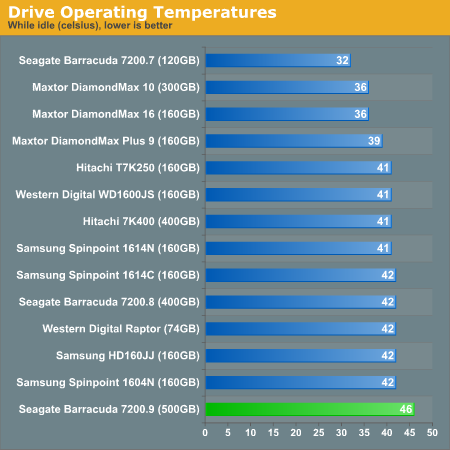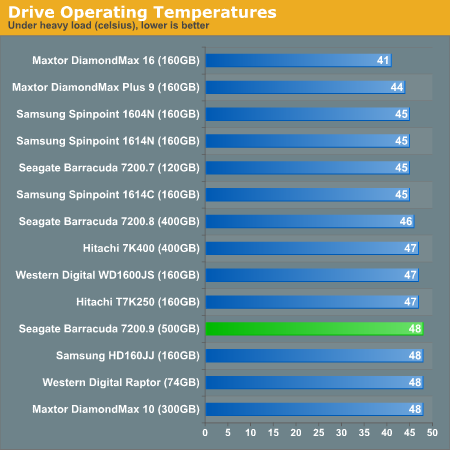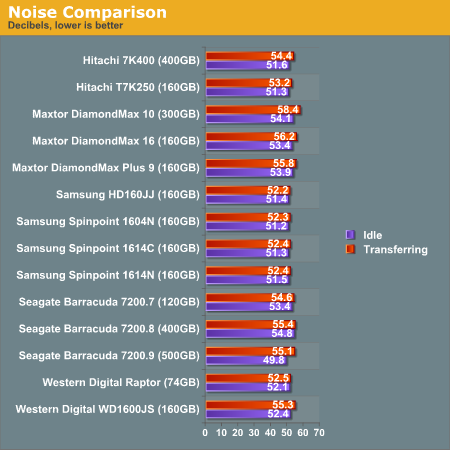Seagate 7200.9 500GB: Mouthwatering Benchmarks
by Purav Sanghani on October 24, 2005 12:05 AM EST- Posted in
- Storage
Thermal and Acoustics
Heat and sound are also two very important factors in drive performance especially when considering where they will be used. A loud hard drive that becomes warm very quickly may not be the best choice for home theater PCs or any PC without adequate cooling, and the noise alone could be a bit annoying. Take a look at how each drive performed as far as heat and noise output goes.
Thermal
Acoustics
To measure the sound output of each drive, we have taken decibel readings of each drive at their startup phase as well as the sound output while there is disk activity.
Heat and sound are also two very important factors in drive performance especially when considering where they will be used. A loud hard drive that becomes warm very quickly may not be the best choice for home theater PCs or any PC without adequate cooling, and the noise alone could be a bit annoying. Take a look at how each drive performed as far as heat and noise output goes.
Thermal


Acoustics
To measure the sound output of each drive, we have taken decibel readings of each drive at their startup phase as well as the sound output while there is disk activity.











46 Comments
View All Comments
gutharius - Wednesday, August 30, 2006 - link
Wanted to ask if during the benchmarking your removed the jumper that sets the Barracuda to SATA150 as opposed to SATA300? Seagate manufactures this drive with the drive set to run SATA150, for compatibility reasons with the VIA chipset. Please check this as I think this drive would fair much better if it were set to run in SATA300 not SATA150.ROcHE - Friday, February 10, 2006 - link
This is getting confusing with all those platters size. Would be great to have these compaired.kd4yum - Thursday, October 27, 2005 - link
HeyThe whole NCQ process has its 'glamour' from SCSI. But really, SCSI just brought it down from Mainframe tech. IF you got 100+ people working a DL/1 or DB2 database, then 'Elevator' queuing pays. Maybe also in a file server (SCSI). But forget it in a Personal Computer! Who you gonna queue?
Its like trying to do file compression in software during a backup. You lose more in computation than you gain in I/O.
sorry for the flame
eastvillager - Wednesday, October 26, 2005 - link
You know how your mouth starts to water right before you're about to vomit? :-)Peter - Tuesday, October 25, 2005 - link
yeah right ... I was so bored with those results I started drooling.formulav8 - Monday, October 24, 2005 - link
I really do not care for the style of this article/review from this new guy. (I am guessing he is new? Don't reconize the name?)I can definitely tell if Anand himself his the author of the article/review or if its one of his fill-in guys. But they do seem to be getting better with time.
And as many others has said, the title of this article is completely 'false' since the review clearly shows the drive to be average at most. This drive is dissappointing for the features it has. High density platters and 16MB cache and it still gets beat by the older 8MB Cache/Lower Density platter drives. Unless I am looking at the graphs wrong??
Jason
Scrogneugneu - Monday, October 24, 2005 - link
Well, look at the graphs the way you want, the middle will always stay in the middle...
tomoyo - Monday, October 24, 2005 - link
Well first of all, I fully agree that the title "mouthwatering" makes no sense whatsoever. Even the conclusion is so-so at best...if the seagate drive had beaten all the other 7200rpm drives..that would be true mouthwatering numbers. It's not even a winner in terms of storage since there's already 500gb drives out there. Nor does it advance platter sizes like the single platter design. So that title is completely false in my eyes.Secondly, I've noticed the writing and analysis has gone greatly downhill since Anand himself hasn't been writing as much. Anand tends to have some insightful commentary on the new technology involved and explainations of the numbers. There's at best shallow explanations of numbers and nothing really distinguishing what's really happening with the benchmarks. And as noted, there's nothing that explains all the different platter sizes in any depth, nor into what pluses or minuses the full SATA 2.5 interface might have in terms of benchmarks and usability. I have to say this is a very disappointing overall job, and I hope the writing and analysis increase by a magnitude of at least 10 to keep up to anandtech standards.
Veerappan - Monday, October 24, 2005 - link
On the final words page is a pic of a read speed test that was performed on this drive.http://images.anandtech.com/reviews/storage/seagat...">http://images.anandtech.com/reviews/sto...eagate_b...
Maybe I am seeing this wrong (or it could be a program limitation), but why is this program reporting that the theoretical limit was 150MB/s? If this drive was being tested at 3.0Gb/s, shouldn't that figure be roughly double what it is?
kd4yum - Thursday, October 27, 2005 - link
Yeah